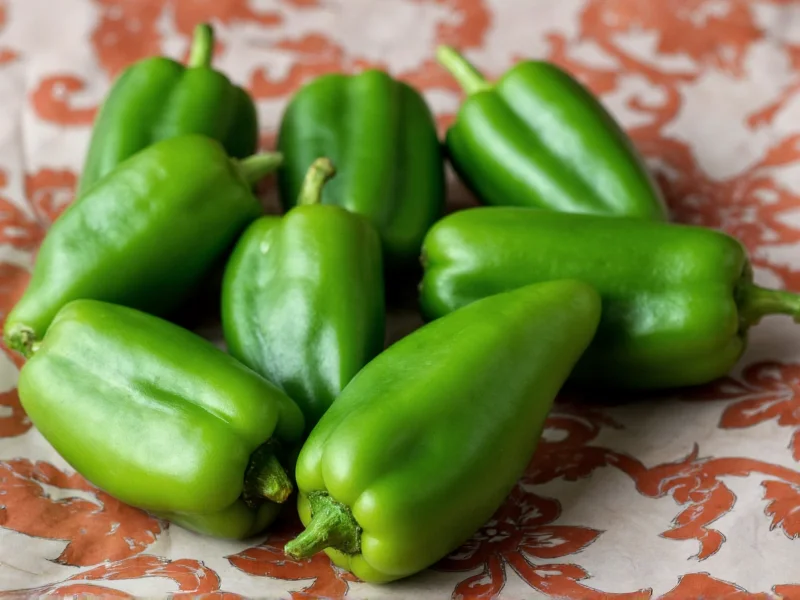When exploring the world of chili peppers, understanding poblano pepper heat levels helps home cooks and food enthusiasts make informed choices for their recipes. These versatile peppers, native to Mexico and commonly used in dishes like chiles rellenos and mole poblano, offer a unique flavor profile that goes beyond just heat.
Understanding Poblano Pepper Heat on the Scoville Scale
The Scoville scale measures chili pepper heat intensity by determining capsaicin concentration. Poblano peppers register between 1,000-2,000 Scoville Heat Units, placing them firmly in the mild-to-medium category. To put this in perspective:
| Pepper Type | Scoville Heat Units | Heat Comparison |
|---|---|---|
| Bell Pepper | 0 SHU | No heat |
| Poblano Pepper | 1,000-2,000 SHU | Mild to medium warmth |
| Jalapeño Pepper | 2,500-8,000 SHU | Moderate heat |
| Serrano Pepper | 10,000-23,000 SHU | Significantly hotter |
Factors That Influence Poblano Pepper Spiciness
Several variables affect how spicy your poblano peppers might be:
- Growing conditions: Stressors like inconsistent watering or extreme temperatures can increase capsaicin production
- Ripeness: Green poblanos are milder, while red-ripened versions (sometimes called anchos when dried) develop slightly more heat
- Individual variation: Even within the same plant, heat levels can differ between peppers
- Seed and membrane content: The white ribs and seeds contain most capsaicin—removing them reduces heat significantly
When Poblano Peppers Might Surprise You
While generally mild, occasionally you might encounter a poblano that delivers unexpected heat. This phenomenon occurs because:
- Genetic variation exists within the poblano pepper species
- Environmental stressors can trigger higher capsaicin production
- Some markets sell mislabeled peppers that resemble poblanos but are actually spicier varieties
If you're sensitive to spice, always taste a small piece before adding poblano peppers to your entire dish. This precaution prevents accidentally creating an overly spicy meal when cooking with fresh poblano peppers.
Culinary Applications of Poblano Peppers
Their moderate heat level makes poblano peppers incredibly versatile in the kitchen. Chefs appreciate them because:
- They provide subtle warmth without overwhelming other flavors
- They have a rich, earthy flavor with notes of tobacco and dried fruit
- They maintain structure when roasted, making them perfect for stuffing
- They blend well in sauces where you want background heat rather than dominant spice
When roasting poblano peppers, their thick skin blackens beautifully, developing a smoky flavor while preserving their characteristic mild heat. This makes roasted poblano peppers ideal for salsas, soups, and as a topping for eggs or tacos.
Substitutes for Poblano Peppers Based on Desired Heat Level
Depending on your spice tolerance and recipe requirements, consider these alternatives:
- For milder heat: Bell peppers (zero heat) or cubanelle peppers (500-1,000 SHU)
- For similar heat: Anaheim peppers (500-2,500 SHU) or Hungarian wax peppers (when yellow)
- For more heat: Jalapeños (2,500-8,000 SHU) or serranos (10,000-23,000 SHU)
Remember that substituting peppers affects not just heat but also flavor profile and texture. Poblano peppers have a distinctive earthy taste that other peppers may not replicate exactly, even when matching heat levels.
Handling Tips for Cooking with Poblano Peppers
To maximize enjoyment of poblano peppers while managing their heat:
- Wear gloves when handling multiple peppers to avoid capsaicin transfer to sensitive areas
- Remove all white ribs and seeds for the mildest preparation
- Pair with dairy products like cheese or sour cream to counteract heat if needed
- Roast and peel to enhance flavor while maintaining manageable heat levels
- Start with one pepper in recipes, then adjust to taste—never add all at once
Understanding poblano pepper heat characteristics helps you use them effectively in various cuisines. Whether you're making traditional Mexican dishes or experimenting with fusion recipes, knowing how spicy poblano peppers are ensures your creations have the perfect balance of flavor and warmth.
Frequently Asked Questions
How hot is a poblano pepper compared to a jalapeño?
Poblano peppers are significantly milder than jalapeños. While poblanos range from 1,000-2,000 Scoville units, jalapeños typically measure 2,500-8,000 units—making jalapeños potentially up to 8 times hotter. Most people find poblanos pleasantly warm without being painful, while jalapeños deliver noticeable heat that can overwhelm some palates.
Can you eat poblano peppers raw?
Yes, you can safely eat poblano peppers raw. Their mild heat level makes them one of the more approachable raw chili peppers. When raw, they have a grassy, slightly bitter flavor with moderate warmth. Many people enjoy them in fresh salsas, salads, or as a crunchy addition to sandwiches. The heat becomes more pronounced when eaten raw compared to when roasted.
Why are some poblano peppers hotter than others?
Natural variation in poblano pepper heat comes from several factors: growing conditions (water stress increases capsaicin), ripeness (red-ripened poblanos are often hotter), and genetic differences between plants. Even peppers from the same plant can vary in heat. The seeds and white membranes contain most capsaicin, so peppers with more of these parts will be spicier. Occasionally, markets sell mislabeled peppers that resemble poblanos but are actually spicier varieties.
Do poblano peppers get hotter when cooked?
Roasting poblano peppers doesn't increase their actual capsaicin content, but it does change how we perceive their heat. The cooking process breaks down cell walls, potentially releasing more capsaicin. More importantly, roasting enhances their natural flavors, which can make the existing heat more noticeable. When peppers are cooked in liquid (like in soups or sauces), the capsaicin distributes throughout the dish, potentially making the overall dish seem spicier even though the total heat hasn't increased.
Are poblano peppers safe for children?
Most children can safely enjoy poblano peppers in moderation. Their mild heat level (1,000-2,000 SHU) makes them one of the more child-friendly chili peppers—comparable to black pepper in intensity for many palates. To make them even milder for children, remove all seeds and white membranes before cooking. Many parents successfully introduce poblano peppers to children through stuffed pepper dishes or mild cheese-filled chiles rellenos, where the cheese helps counteract any heat.











 浙公网安备
33010002000092号
浙公网安备
33010002000092号 浙B2-20120091-4
浙B2-20120091-4